Strategic Easter Email Campaigns Can Put a Spring in Your Marketing Step
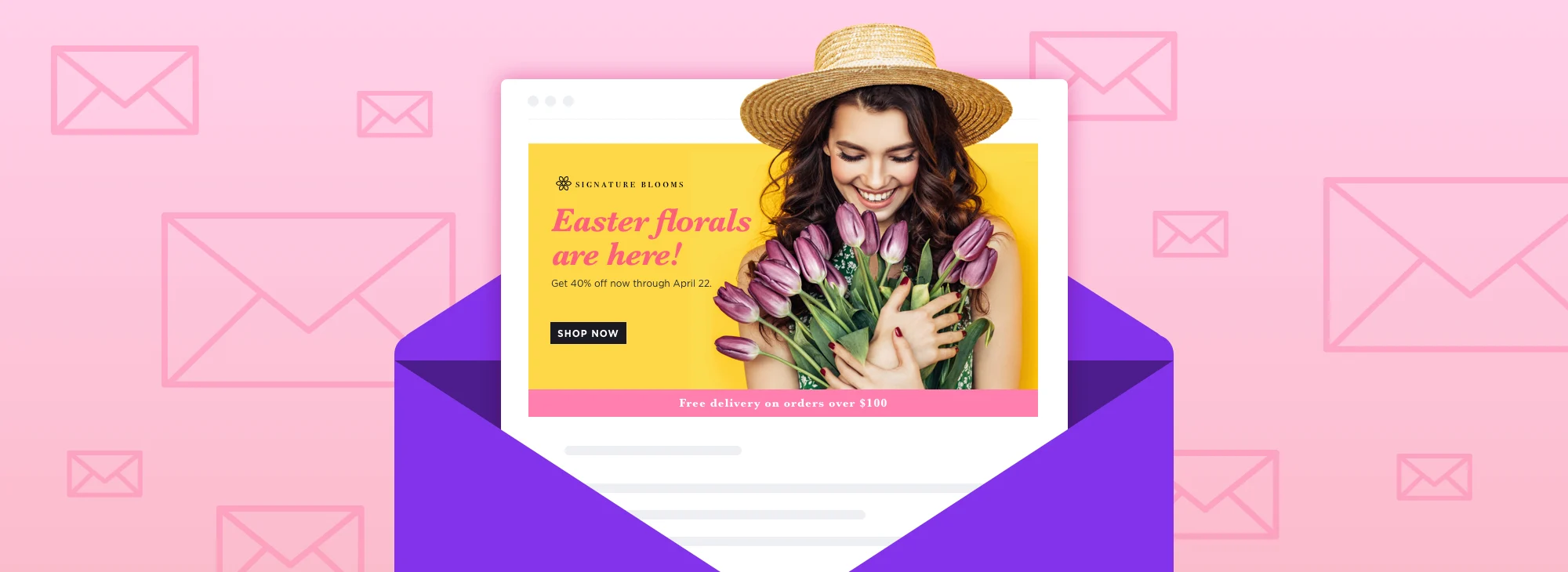

Strategic Easter Email Campaigns Can Put a Spring in Your Marketing Step
Get The Print Version
Tired of scrolling? Download a PDF version for easier offline reading and sharing with coworkers.
A link to download the PDF will arrive in your inbox shortly.
Easter falls a bit later this year — on April 21st — which means you have extra time to pull together an Easter-themed email campaign.
More than $18 billion in spending is potentially at stake, and email campaigns are beginning to show up in inboxes now.
So, pardon the pun, but hop to it, and investigate how an Easter campaign could help you generate extra revenue.
Easter by the numbers
The National Retail Federation surveys U.S. consumers and has a whole set of statistics that predict how they’ll spend this Easter.
Below are key statistics from the NRF’s 2019 survey of U.S. consumers:
Total spending is estimated at $18.1 billion.
8 in 10 Americans say they plan to celebrate the holiday.
Per-person spending is estimated at $151.
9% said they planned to spend at least part of Easter Sunday shopping online, while another 8% planned to shop in stores.
Food ($5.74 billion) is the No. 1 purchase, followed by $3.27 billion on clothing, $2.9 billion on gifts and $2.5 billion on candy.
In the U.S., Easter is one of the top spending holidays after the Christmas/Holiday season, behind Back to School, Valentine’s Day and Mother’s Day but ahead of Father’s Day and Halloween.
In the UK, Easter ranks higher – it’s second only to Christmas in spending because it falls on a four-day “bank holiday,” or public holiday.
Easter and email
Easter is a busy time for email marketers, which is another reason you might want to dip your toes into creating an Easter-themed holiday campaign, even if your brand isn’t a natural fit with Easter.
Here’s what we saw in the MailCharts database with Easter promotional campaigns for 2018:
1. Most campaigns were sent before Easter Sunday, although some brands sent directly on Easter, and others continue to send even several days after the holiday.

2. Easter emails begin showing up in the inbox well before the holiday.
The graph below shows the frequency of Easter-themed email campaigns in 2018, when Easter fell on April 1.
It shows how early marketers began sending campaigns as well as how long after the holiday they continued to land in the inbox.
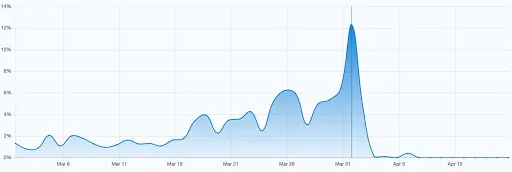
3. The percentage discount is by far the most popular Easter promotion, with discounts of 20% to 30% being the most popular.

Easter campaigns help you connect and compete
A quick glance through your own inbox in the weeks leading up to Easter will show you how seriously many brands focus on Easter.
Besides being a key event on the Christian calendar, Easter is also a popular time for travel, getting families together and moving headlong into spring.
Many brands that don’t have an obvious connection to Easter-themed merchandise can tag along with the general interest in the holiday by changing the email template color palette to Easter-friendly colors – greens, pastels – and adding Easter-themed artwork as appropriate.
If your brand has never sent an Easter-themed campaign before, consider the benefits to adding an Easter email this year:
1. Easter is a popular holiday, and participants are in a shopping mood.
As we noted above, Easter is on the radar for 8 of 10 Americans, even the ones who don’t participate in traditional activities like going to church (just over half will attend services) or hunting for Easter goodies (65% won’t be doing an egg hunt).
But almost everybody who plans to celebrate Easter will be out shopping before the holiday.
Sending an email with even a subtle Easter theme will help your messages connect with people who have the holiday on their minds and might otherwise scroll past your message if it’s just business as usual.
2. An Easter campaign is a timely reason for sending another email to subscribers.
On one hand, you need to stay in touch regularly with your subscribers. On the other, you don’t want to annoy them by sending too many emails.
Sending a holiday-themed email allows you to capitalize on the moment with a message keyed to the day, especially if you sell products that fit in with the holiday theme.
If your brand doesn’t have that natural tie-in, sending a simple message saying “Happy Easter” can add some variety to your regular email schedule.
5 tips for effective Easter email campaigns
Just adding a few bunnies and chicks to your regular email message won’t be enough to move subscribers to act.
Follow these steps to be sure you send a message that will attract subscribers’ attention, intrigue them enough to open it and then act on it.
1. Set your goal for your Easter campaign email.
This must be your first step, whether you’re testing an Easter email or looking to improve on your past campaigns.
Every email you send, whether it’s a specialty email, “business as usual” message or triggered/transactional email, must have a goal.
These are potential goals for an Easter message:
Raise incremental revenue to help you achieve a quarterly or annual goal.
Send a goodwill message.
Test a new promotional tactic (higher discount, dollar versus percentage discount).
Increase store traffic.
Reconnect with inactive subscribers or those who are in danger of falling off your active list.
In years when Easter lands closer to the first day of spring, many retailers focus their Easter messages on launching or highlighting spring merchandise lines.
When Easter falls this late in the season, a spring theme could focus on highlighting secondary merchandise lines instead of sneak peeks.
2. Send a non-promotional message along with a promotion, or even instead of it.
Most of the Easter emails in the MailCharts database will have some kind of purchase incentive attached. (See the section “Easter by the numbers” above to see which promotions are most popular.)
However, many marketers will either add an Easter greeting to a promotional email or skip the promotion entirely, as Hobby Lobby does.
Your customers will be checking their emails anyway.
The holiday might be a good day to give them a message that says something besides “Buy this.”
However, if your marketing manager frowns on the idea of sending a “warm fuzzy” email, go ahead and include a reward for your Sunday shoppers who take the time to open your message.
3. Send your Easter email more than once.
As you can see from the frequency chart in the “Easter and email” section above, marketers begin sending their Easter emails well before the holiday, although the most popular day to send is on Easter itself.
Your email will have plenty of competition in the inbox if you send it only on Easter Sunday or the day before.
So, to get maximum exposure, send your message 10 days to two weeks before and then again on or around Easter.
You can also send a reminder about your Easter promotion up to several days after the holiday, too. If you go this route, consider sending the message only to subscribers who didn’t open or act on your first message.
That way, you won’t annoy people who did open, click or convert on your first email.
4. Avoid Easter clichés in subject lines.
Your subscribers’ inboxes are going to overflow with Easter puns and attempts at clever wordplay, like using “eggs” instead of “ex” to create words like “eggs-cellent,” “eggs-treme,” “eggs-tra” and so on.
They’re fun the first couple times you hear them, but when everybody else is doing it, your pun loses its punch.
How about an Easter emoji instead? Bunnies, chicks, eggs, flowers … all of those can attract the eye and add a little Easter sunshine to the inbox.
Whatever clever bit you come up with, remember to follow good subject-line best practice.
Be sure your subject line gives your subscribers a reason to open it. Tell them what’s inside or give them a broad hint about your offer or value. “Happy Easter!” is a nice sentiment, but it’s easy to scroll past it.
5. Target your younger customers.
Does your brand naturally skew younger? Or can you identify your Millennial-age customers? An Easter campaign could help you drive higher engagement.
Here’s an interesting finding from the NRF’s 2019 survey:
“Those under age 35 really embrace every aspect of the holiday, from the traditional to the whimsical. These younger consumers are even more likely than the average adult to say they plan on celebrating Easter and are the only age group that’s seen a consistent increase in those celebrating compared with a decade ago.”
That includes a greater tendency to shop, even on the holiday itself:
85% of Millennials (ages 18-34) plan to celebrate Easter, compared with 80% of Generation X (35-55) and 74% of Boomers and Seniors (ages 55+).
Millennials are more likely to web-surf, open gifts and shop (online and in stores) on the holiday.
They’re also more likely to browse and buy on their smartphones than shoppers in the general population (37% versus 24%).
One final tip: Compare your results with a typical campaign.
Look for opens, clicks and conversions to see how well your Easter email performed.
Don’t stop at these basic metrics, though.
Look for order size, new versus regular buyers, browse sessions linked to the email and other metrics that measure the kinds of actions your email drove on your website.
Even non-promotional messages can drive some incremental actions, such as purchases or extended browsing sessions.
Look deeper to find the real impact of your Easter email.
Also, keep checking your email to see if it has any long-tail effects. One of email’s great benefits is that someone can find your message days or even weeks after you send it and then click on it.
Check back several days, a week or several weeks later to see if your email is still percolating in the inbox.
Stand-out subject lines for Easter
Need some Easter subject-line inspiration? These subject lines are already popping into inboxes.
We also added a couple of our favorites from Easters past:
Reveal Your Deal ???? Easter Offer Inside
Celebrate Easter ???? with extra savings!
Don’t Miss Your Easter Weekend Treat – 40% Off All Full Price
Easter Spectacular With Up To 70% Off
???? Every Bunny Ready for Easter?
Every Bunny Loves Easter – Schedule your Easter Gift Delivery Today!
Get HOPPY! PS Is Your ONE-STOP Shop For All Things Easter.
You won’t find these goodies in an Easter egg.
???????????? Load Up Those Easter Baskets….
???? The Easter bunny has one more surprise…
Don’t Let This Easter Egg Go Bad!
Crack open your Easter treat!
3 exemplary Easter examples
Things Remembered
Sender: Things Remembered
URL: https://www.mailcharts.com/emails/17cff755-7499-aca5-bf3a-eabb2f004e0e
Subject line: Oh, Hoppy Day!
Preview text: Enjoy a day filled with sweet surprises and heartwarming traditions.
This is a near-perfect Easter email. Here’s why:
The simple Easter sentiment is the primary focus of the message, but the content around it has the potential to drive conversions from the email, whether as sales or as browsing session from people looking forward to gift-giving occasions like Mother’s Day.
The email recycles the artwork from the previous year’s Easter email but updates the message. That’s a quick and easy way to recycle content and keep it.
Although the subject line veers close to cliché (you’ll see many variations on “hop” around Easter time), this version is in keeping with the mood of the day.
The preview text reinforces the promotion-free sentiment of the subject line.
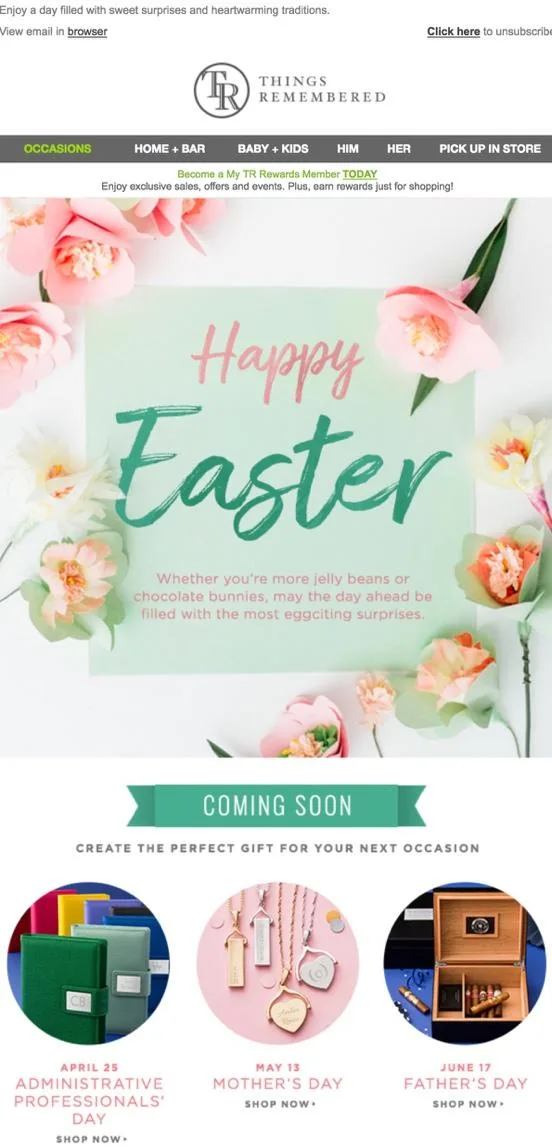
Want That Trend
Sender: Want That Trend
URL: https://www.mailcharts.com/emails/9de36b1d-4c74-00b3-430c-307be055131f
Subject line: Crack open for some bun-derful Easter treats! ????????????
Preview text: It’s time to shop!
We picked this email because it has a fresh Easter vibe and uses animated GIFs to pack lots of fashion inspiration into a single email. We also loved the subject line because it’s a pun we don’t see too often, and the three emojis reflect the spring-floral art inside the email.
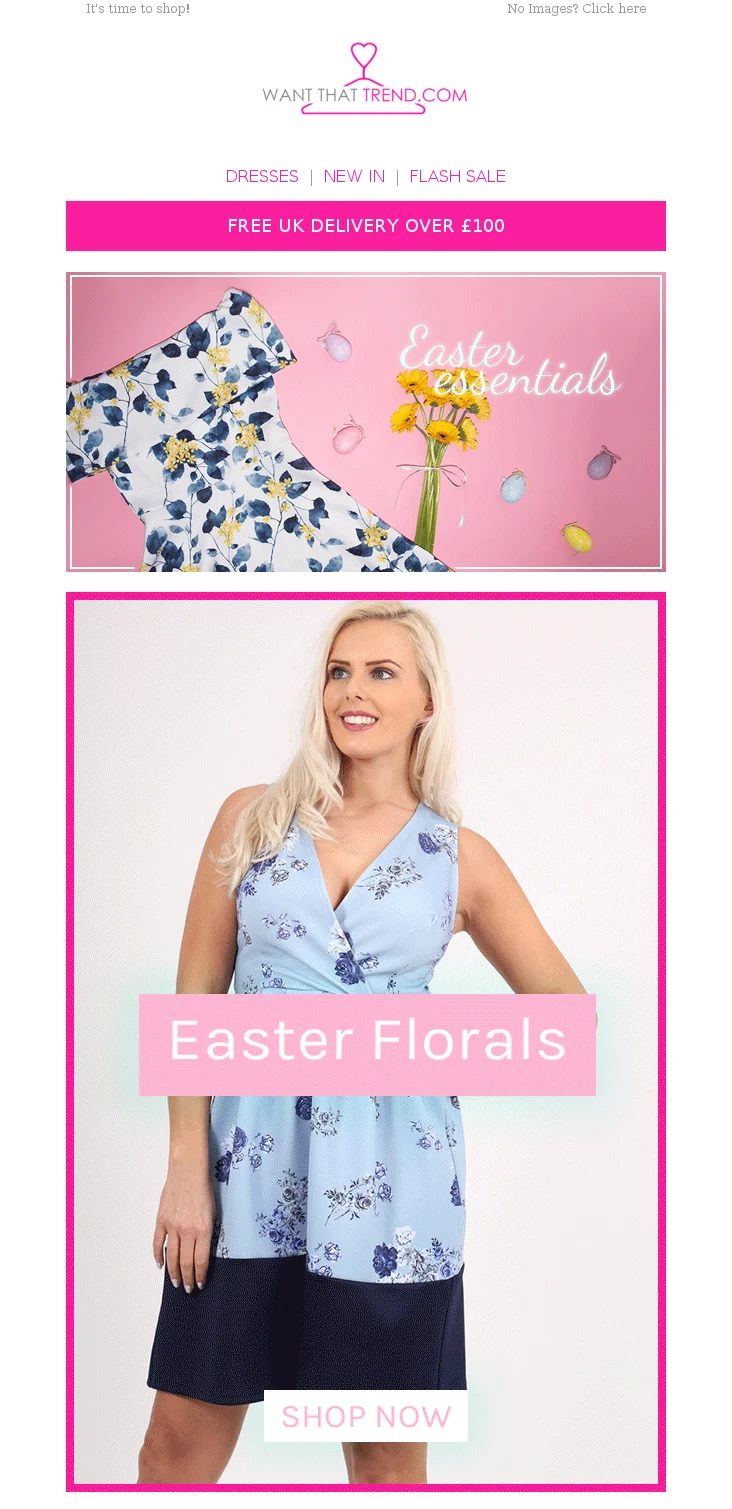
Criquet Shirts
Sender: Criquet Shirts
URL: https://www.mailcharts.com/emails/328aa45b-dadd-b806-576a-8b1b4b5e013d
Subject line: Wear Pastels This Easter (Brunch Will Taste Better)
Preview text: You’ll also look better in the family photos.
We loved this email from the minute we saw the clever subject line and the preview text that continues the thought.
We also liked the cheerful Easter vibe that the shirt display gives off and the “Hop to It” call to action. In a subject line it could be overkill, but here, it’s a clever nudge.
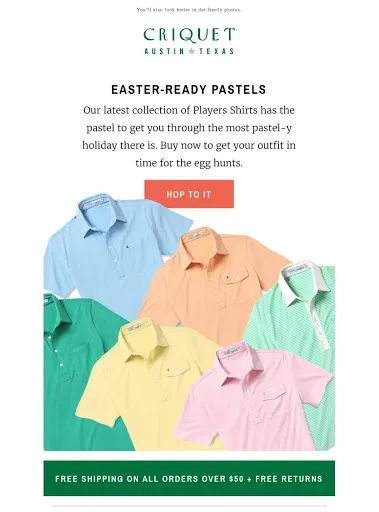
Conclusion: Make Your Easter Email Stand Out
With U.S. consumers alone spending upwards of $18 billion a year on Easter treats, meals, gifts, clothing, decorations and more, even highly specialized retailers can find and claim their share of the market.
Aside from the sheer size of the market, Easter-themed emails can help you compete with other marketers in the inbox and connect with customers who are already in an Easter frame of mind.
If you haven’t tried an Easter email yet, take some time to plan and test a simple Easter email. Keep these basic steps in mind:
Decide on your goal for your Easter campaign email.
Send a non-promotional message along with a promotion—or even instead of it.
Send your Easter email more than once.
Avoid Easter clichés in subject lines.
Compare your results with a typical campaign.
If your brand doesn’t send holiday-themed email messages as a rule, Easter is a good time to test the waters with a simple message or a regular campaign tweaked with creative content that reflects the holiday.
Whether you’re seeking additional revenue or just a way to let your customers know you care about them, an Easter email can be the big treat in your email Easter basket.

Tom Buchok is Director of Product for MailCharts—the data platform built for e-commerce companies looking to get professional about their email marketing strategy and execution.


